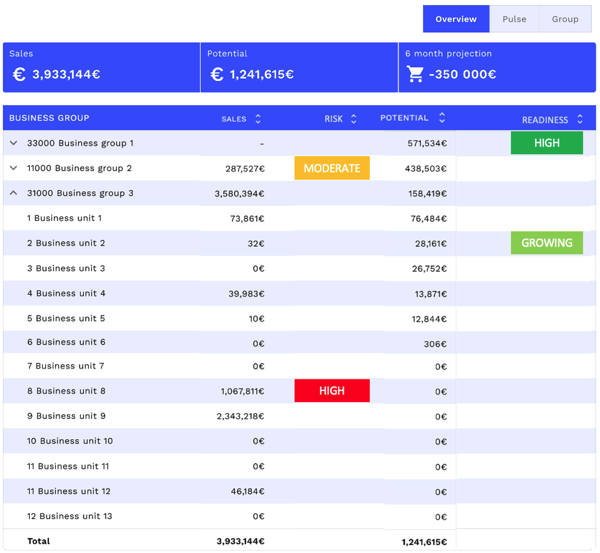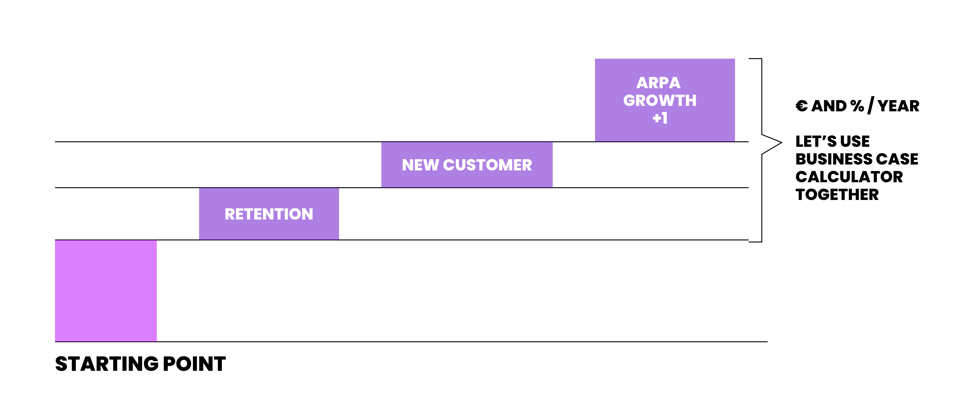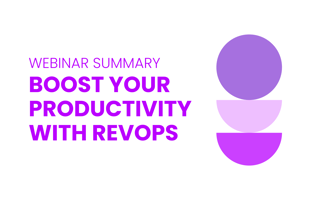In our webinar about how to boost your productivity with revenue operations (RevOps), we focused on...
Risk and Readiness Defined - Next Best Action & priorities
We are living in an age of uncertainty and technological disruption, that is demanding more and more with less resources.
According to Salesforce's State of Sales 2023 research, productivity is the most pressing imperative this year. The burning question is: "What should I do next? Where should I allocate my time right now for the best possible impact".
The allocation of time is best shared and prioritised between two opposites 1) Risk and 2) Readiness. The data is available, but making sense of it is the challenge. Making sense of it is the first step, taking those findings to operational reality is another.
We have kept it simple for account managers to run with it:

RISK
Eroding customer loyalty is a challenge that is constantly getting worse in this time of unprecedented uncertainty. There are different types of negative churn that needs to be discovered:
- Agreement renewal: The risk and probability of not renewing agreement for the next term
- Declining sales: Not leaving completely, but the annual billing level is constantly eroding in varying velocity
- Passivation: The agreements or legal collaboration stays intact, but billing ends completely
This challenge is very expensive for companies. Data from Forbes indicates that 65% of company's business comes from existing customers, and increasing customer retention by 5% increases profits by 25% to 95%.
CASE: In an example client case we did risk analytics and set the probability of churn to 75% for high risk flag. The outcome of those customers was that 78% defected in the following couple of months. We then looked at companies that had defected and how many of those we were able to flag with risk in advance. We learned that only 1/8 companies that defected left without prior risk flag. Currently, we are collecting success story and financial benefits for this customer for later publication.
In another case when Covid-19 hit the markets, an industrial company had risk-monitoring up and running and had Low and High risk customer types. The Covid-19 impact resulted in 180-degree risk shift. The customers that used to be secure became high risk customers and the other way round. The speed to discovery, decisions and actions is a management imperative.
READINESS
The first step in analysing markets is to define Strategic Segmenting and which types of companies are out of market, which are in addressable, obtainable and active markets. Dive deeper into these fundamentals in our blog post here.
Readiness indication tells you that the customer's and market's conditions are favourable for you to close sales.
In case the Readiness is at "High" -level the customer is in the active markets: learning about your offerings, downloading white papers etc. In case the customer is already active, they are also likely to actively learn about competition. The customer sits behind the steering wheel and the salespeople need to take action and take charge of the customer's process.
The optimal time to open dialogue with customers is when they are in obtainable markets, not actively searching and comparing yet. When they become active, you are in a win or lose position trying to catch up with the customer.
However, these two simple perspectives give answers to productivity imperative and demand.
FUNDAMENTALS
In actual risk and opportunity monitoring and discovery work there are things that are incredibly difficult to discover, but once uncovered they seem rather obvious. When something changes in the operating environment or in the situation of the customers, the same factor may have positive readiness (= buying probability increases) in some offerings and negative risk (= probability of churn/defect increase) in others. The same applies to customer segments: When Covid-19 hit the markets, the majority of companies were in trouble because of disappearing customers and others had difficulties meeting exploding demand. Video negotiation solutions, streaming companies, DIY hobbies and gardening markets, for example, were in explosive growth as well as eCommerce in general.
Changes in the markets are constant and the level of uncertainty has peaked in the past years. We are incapable of predicting the outcomes of Black Swans, but even they have impacts related to factors that can be constantly monitored and interpreted.
Our approach to risk is to analyse individual customer ID's and learn from the past. This is an evidence based approach that constantly learns more. In aggregated views these answers are invaluable for C-level decision makers and have a lot to offer for strategic consideration. Discovering "Addressable and Solvable Challenges", as Richard Rumelt referred to them in his book "The Crux - How leaders become strategists" , has never been as easy and intuitive.
Education of the datamodel and AI machine learning tools requires years of historical data and modelling how different changes influence customers in different types of companies. This is evidence based analytics and it can only answer questions that can be drawn from the history. However, even in case of a Black Swan the speed of discovery and insights will be much faster in case the modelling is ongoing.
NOTE! We are serving enterprise customers in wildly different business sectors. There is no single datarecipe that would suit everyone. The iterative curation and learning is a must have process to meet individual company's needs.
Our approach to monitoring and managing this turmoil and making sense of it is founded on three different types of data:
.png?width=600&height=600&name=priorities%20risks%20and%20next%20best%20action%20(1).png)
RELATIONSHIP
This is your own data about events and engagements happening in your own interfaces. You have a lot of this data, the availability of data is not a challenge, making sense of it is. Companies have done a lot with the data they have in their data warehouses and data lakes, the next stage in pragmatic value generation is to connect it with external data.
CUSTOMER STATUS
Customer companies are in constant change and markets are treating them differently. However, the changes in customer's situation gives direct answers about both risks and opportunities related to your collaboration with them.
MARKET ENVIRONMENT
The market turbulence has varying influence on countries and states too. E.g. the inflation rate in the past year in Finland was about 8.2% and in the neighbouring countries Sweden and Estonia the level was around 20%. The conditions in these countries were drastically different. The customers you are serving need to survive in these conditions and the changing conditions will influence companies with varying velocity. Local conditions are necessary to take into account in case of multinational companies or those selling to international markets.
COMPETITION
Data about competitors activities is difficult to procure, but is definitely an interesting factor. Lets discuss more in person :)
CUSTOMER LIFETIME VALUE AND REVENUE MANAGEMENT
Managing risk systematically has a lot to do with how your customer relationships are built. In case you are capable of increasing offering penetration in your customer relationships, you are simultaneously preventing risks and improving average revenue per account per year.
The combined effect of risk management and cross-selling as well as more effective new customer hunting will will have a significant impact on your overall revenue management and market share:

If you are interested in discussing more and making a business case for your company. Please book a meeting for further discussion




.png?height=200&name=CUSTOMER%20SEGMENTATION%20SOFTWARE_%20FEATURES%20AND%20COMPARISONS%20(13).png)